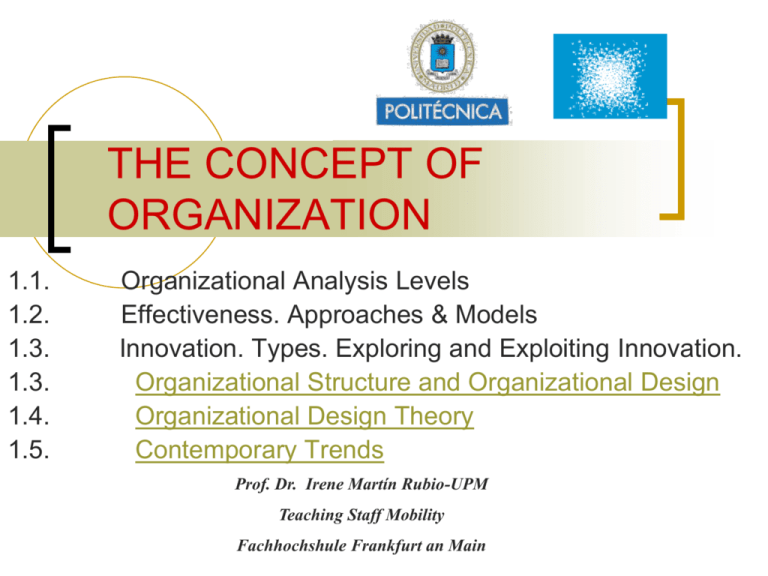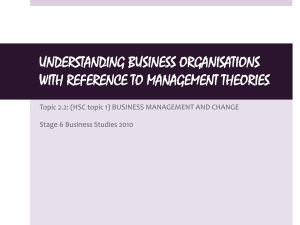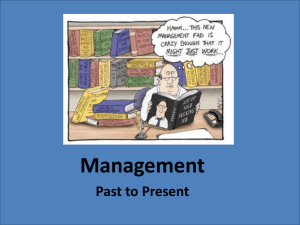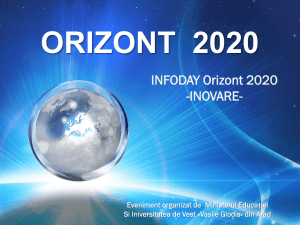on the concept of organization
advertisement

THE CONCEPT OF ORGANIZATION 1.1. 1.2. 1.3. 1.3. 1.4. 1.5. Organizational Analysis Levels Effectiveness. Approaches & Models Innovation. Types. Exploring and Exploiting Innovation. Organizational Structure and Organizational Design Organizational Design Theory Contemporary Trends Prof. Dr. Irene Martín Rubio-UPM Teaching Staff Mobility Fachhochshule Frankfurt an Main ORGANIZATIONAL ANALYSIS LEVELS INDIVIDUAL - GROUP - ORGANIZATION OUTCOMES OF ORGANIZATIONS INTERDISCIPLINARY STUDY 2 ORGANIZATION ARTIFACT GOAL DIRECTED SOCIAL ENTITY STRUCTURE ACTIVITY NOMINAL BOUNDARY 3 EFFECTIVENESS MODELS, APPROACHES 4 EFFECTIVENESS Definitions Ex. Volumen of output, profit, costumer satisfaction, dividends... GOAL EFFECTIVENESS The degree to which an organization realises its goals. Meeting outputs schedules. The capacity to adapt to changing environments. EFFICIENCY Quantitative dimension The ratio of inputs to outputs in a process or organisation. 5 APPROACHES TO EFECTIVENESS • THE SYSTEMS RESOURCE APPROACH • THE INTERNAL PROCESS APPROACH – COORDINATION • THE GOAL APPROACH • THE STAKEHOLDER APPROACH – INTEREST GROUPS IN THE ORGANISATION • THE INTEGRATIVE APPROACH 6 THE SYSTEM APPROACH INPUTS OUTPUTS External Environment vs. Internal Environment Sub-Environments: Organizational System Social ; Technical; Political ; Economic Functional Systems: Financial, Marketing, Operations, Human Resource.... 7 THE INTERNAL APPROACH ORGANIZATION DESIGN SUPERVISORS & STRUCTURE GOOD TEAM SPIRIT CONFIDENCE AND TRUST LOCAL DECISION MAKING ORGANIZATIONAL COMMUNICATION BEHAVIOR CONFLICT RESOLUTION INTEGRATION 8 THE GOAL APPROACH GOAL STRATEGIC GOALS OPERATIVE GOALS CRITERIA PERFORMANCE ( ACCOUNTING) 9 THE STAKEHOLDER APPROACH GOVERNMENT Local Authority Media COMMUNITY Other firms Employees ORGANIZATION Clients Universities Consumers Suppliers Banks Insuarance Companies OWNERS 10 AN INTEGRATIVE MODEL OF EFFECTIVENESS ENVIRONMENT The economy Competition Resources INTERNAL EFFECTIVENESS Capacity Technology Physical conditions Systems and structure Groups and intra-group relations Leadership INDIVIDUAL EFFECTIVENESS Ability Expectations, outcomes Rewards Organizational Effectiveness 11 INNOVATION KNOWLEDGE SOCIETY 12 INNOVATION Innovation Invent + Commercialization Open innovation: the use of purposive inflows and outflows of knowledge to accelerate internal innovation and to expand the markets for external use of innovation, respectively”. (Chesbrought 2003) 13 Invent + Commercialization PATENT TECHNOLOGY MARKET INVENT VS. PRODUCT MARKET 14 INNOVATION Types of innovation, OCDE- Oslo Manual-2005: PRODUCT INNOVATIONS PROCCESS INNOVATIONS ORGANIZATIONAL INNOVATIONS MARKETING INNOVATIONS http://www.oecd-ilibrary.org/science-and-technology/oslomanual_9789264013100-en 15 EXPLORING AND EXPLOITING INNOVATION The Roman god Janus had two sets of eyes—one pair focusing on what lay behind, the other on what lay ahead. TOMORROW VS. TODAY BUSINESS EXPLORING AND EXPLOITING INNOVATION AND EFFECTIVENES Ambidextrous Organizations: http://hbr.org/2004/04/the-ambidextrous-organization/ar/1 16 The Innovation Paradox http://www.nasa.gov/offices/oce/appel/ask/issues/41/41i_ paradox.html Sometimes organizational "support" kills good new ideas. Entrenched ways of doing things and bureaucratic caution can and do discourage innovation in organizations, but even organizational support for new ideas can be a mixed blessing. How should the designed the organizations to promote INNOVATION? 17 Organizational Structure And Organizational Design 18 ORGANISATIONAL STRUCTURE The fundamental and relatively unchanging features of an organisation which are officially sanctioned by those who control it and consist of the way activities and component parts are grouped, controlled and coordinated in order to achieve specific aims and outcomes. 19 ORGANISATIONAL CHART MANAGING DIRECTOR MARKETING DIRECTOR SALES MANAGER ADVERTISING MANAGER FINANCE & ADMON DIRECTOR MANAGER MANAGEMENT ACCOUNTS MANAGER FINANCIAL ACCOUNTS OPERATIONS DIRECTOR PRODUCTION MANAGER MAINTENANCE MANAGER TECHNICAL DIRECTOR R&D MANAGER DESIGN OFFICE MANAGER Mgm.ACC1 Mgm.ACC2 PUBLICITY MANAGER Mgm ACC3 20 MACRO AND MICRO STRUCTURE MACRO STRUCTURE Expresses the general form of structure and what is expected of organisational members. Organizational Chart, Board Committes, Planning & Control Procedures, Departmentation, CoordinationMechanism MICRO STRUCTURE: OPERATING MECHANISMS Indicates in greater detail what is expected of individuals in a structure. Job Descriptions, Training & Development, Staff Appraisal, Control & Operating Procedures 21 ORGANISATIONAL DESIGN It consists of a body of knowledge that provides guidelines for designing appropriate structures. 22 ORGANIZATIONAL DESIGN FORMAL ORGANIZATION - ORGANIZATIONAL CHART & STRUCTURE INFORMAL ORGANIZATION ORGANIZATIONAL BEHAVIOUR 23 ORGANISATIONAL DESIGN THEORY CLASSICAL APPROACH TAYLOR FAYOL MAX WEBER AND BURAUCRACY CONTINGENCY THEORY ORGANISATIONAL SIZE TECHNOLOGY ENVIRONMENT CULTURE, STRATEGY STRUCTURAL CONFIGURATION: ORGANIC vs. MECHANIC ORGANIZATION 24 CLASSICAL APPROACH TAYLOR THE FATHER OF THE SCIENTIFIC MANAGEMENT CONSULTING ENGINEER INCREASING EFFICIENCY IN PRODUCTION NOT ONLY TO LOWER COSTS AND RAISE PROFITS, BUT ALSO TO MAKE POSSIBLE INCREASED PAY FOR WORKERS THROUGH HIGHER PRODUCTIVITY. THE PRINCIPLES OF SCIENTIFIC MANAGEMENT REPLACING RULES OF THUMB WITH SCIENCE (ORGANIZED KNOWLEDGE) OBTAINING HARMONONY IN GROUP ACTION, RATHER THAN DISCORD ACHIEVING COOPERATION OF HUMAN BEINGS, RATHER THAN CHAOTIC INDIVIDUALISM WORKING FOR MAXIMUM OUTPUT DEVELOPING ALL WORKERS TO THE FULLEST EXTENT POSSIBLE FOR THEIR OWN AND THEIR COMPANY’S HIGHEST PROSPERITY !!! DESIGN WORK SYSTEM. SPECIALIZATION 25 OTHER AUTHORS: GANTT, GILBRETH CLASSICAL APPROACH FAYOL ( MODERN MANAGEMENT THEORY) ACTIVITIES OF A FIRM: THECNICAL: PRODUCTION COMMERCIAL: SELLING AND EXCHANGE FINANCIAL: SEARCH FOR OPTIMUM USE OF CAPITAL SECURITY: PROTECTION OF PROPERTY AND PERSONS ACCOUNTING: INCLUDING STATISTICS MANAGERIAL: PLANNING, ORGANIZATION, COMMAND, COORDINATION AND CONTROL. 26 FAYOL’S PERSPECTIVE Division of work: Specialization of managerial as well as technical work Authority and responsibility: He sees both of them as a combination of official (position) and personal ( intelligence, experience, moral growth, past service, etc.) factors. Discipline: Discipline as “respect for agreements which are directed at achieving obedience, application, energy, and the outward marks of respect. Unity of command and direction: Employees should receive orders from one superior only. Each group of activities have the same objetive and the same plan. Subordination of individual to general interest Remuneration : Fair and to satisfay employees and employers. Centralization Scalar chain: Chain of superiors Order: Material and social order. “A place for everything and everyone”Equity: Justice when dealing with subordinates Stability of tenure Initiative: It is one of the “keenest satisfaction for an intelligent man” Esprit of corps: “In union there is strenght”. The need for teamwork and the importance of communications in obtaining it. 27 CLASSICAL APPROACH MAX WEBER AND BUREAUCRACY THREE BASIC FORMS OF AUTHORITY: CHARISMATIC: TRADITIONAL RATIONAL-LEGAL IDEAL TYPE BUREACRACY SPECIALISATION HIERARCHY RULES IMPERSONALITY APPOINTMENT PROGRESSION EXCLUSIVITY SEGREGATION ACCURATE WRITTEN RECORDS CRITICS: GOAL DISPLACEMENT, FRUSTRATION 28 THE CONTINGENCY APPROACH THE MOST APPROPRIATE STRUCTURE FOR AN ORGANISATION IS ONE THAT MATCHES ITS PARTICULAR CIRCUMSTANCE. CONTINGENCY FACTORS: ORGANIZATIONAL SIZE, ORG. AGE TECHNOLOGY ENVIRONMENT OTHERS: STRATEGY, CULTURE, POWER, KNOWLEDGE SYSTEM. 29 THE CONTINGENCY APPROACH MECHANISTIC ORG. BUREAUCRACY Rigid structure Environment : Stable Specialization Hierarchic structures Precise definitions of rights, obligations and technical methods Knowledge is located at the top of the organization. Loyalty Governed by superiors Vertical relationships EFFICIENCY ORGANIC ORG. Fluid sets of arrangements Environment: Turbulent Special knowlege is valued. Continual redifinition of individual task Spread of commitment Network structure of control authority. Communication consists of information and advice rather than instructions and decisions FLATTER ORG. AND LOWER DEGREES OF SPECIALISATION, CENTRALISATION OF AUTHORITY AND STANDARDISATION. INNOVATION 30 ORGANIC vs. MECHANISTIC Innovation • Small close knit groups • Informal organization Formalization • Large specialized groups • Hierarchical organization 31 DESIGN PARAMETERS DESIGN PARAMETER JOB DESIGN •Job Specialization •Behavior Formalization •Training & Indoctrination SUPERSTRUCTURE •Unit grouping (Departm.) DESIGN •Unit Size •Centralisation LATERAL LINKAGES DESIGN •Planning & Control Systems ••Liasion devices •Coordination Mechanism CONTINGENCY FACTORS • AGE & SIZE •ENVIRONMENT •TECHNOLOGY •STRATEGY •CULTURE •POWER •KNOWLEDGE STRUCTURAL CONFIGURATIONS 32 COMTEMPORARY TRENDS 33 CONTEMPORARY TRENDS GLOBALISATION: CUSTOMER RELATIONS AND ADAPTABILITY: FLEXIBLE SPECIALISATION ADVANCED TECHNOLOGY: COMPUTER INTEGRATED MANUFACTURE HUMAN RESOURCES: TQM, JIT. FEWER ROUTINE JOBS. TEAMWORK DOWNSIZING, RIGHTSIZING AND DELAYERING: FLATTER HIERARCHIES BUSINESS PROCESS RE-ENGINEERING: New radical approaches to organisational designs WORKPLACE CHALLENGES: Heteregeneous and diverse working population and working arrangements THE CHALLENGE OF ETHICS: ROLE REQUIREMENTS: Personality and role of the job LEARNING ORGANISATIONS: Every experience is regarded as a 34 learning opportunity. Thus experimentatios is encouraged QUESTIONS ? SUGGESTIONS? IDEAS? 35







